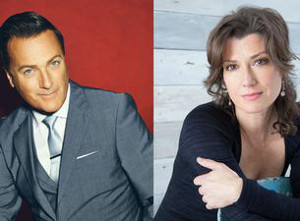A light snowfall on the ground and clinging to the trees, red and green lights illuminating the façade of Jones Auditorium on the campus of Meredith College, snowflakes projected on the walls, and Santa hats scattered throughout the orchestra set the stage for a perfect Christmas concert. Of course, the snow, the cold weather, and a light drizzle also kept some of the usual audience away as well. The Raleigh Symphony Orchestra and the Meredith College Dance Ensemble provided a little bit of everything for those who braved the weather. There were carols and light classics, grand ballet and interpretive dance, and an audience sing-a-long for all to get into the Christmas mood. To my disappointment there was nothing to celebrate Hanukkah – or Kwanzaa for that matter.
The Raleigh Symphony Orchestra, still in its premiere season under the direction of Jim Waddelow, lifted off the sled filled with musical gifts for the audience with a rousing arrangement of “Deck the Halls,” arranged by Walter. It had the flavor of a Leroy Anderson piece, rousing, clever, and boisterous, and it was played with enthusiastic and well controlled vigor.
“Valse Triste” (“Sad Waltz”) Op. 44, No. 1, by Sibelius, is part of his incidental music for Kuolema (Death), a play by his wife’s brother, Arvid Järnefelt. It was casually published in 1905 under a contract that allowed the composer minimal financial compensation. Though it brought Sibelius very little income, it became one of his most frequently performed pieces. He later added another piece from the same play; “Scene with Cranes,” which was published posthumously in 1973 as Op. 44, No. 2. The orchestra played both pieces, which struck this listener as very un-Christmas like music for this concert. Both were played with competent musicianship, though the “Valse Triste” lacked some of the dramatic rubato that is usually employed, and the tranquil and ethereal music of “Scene with Cranes” was a mite shaky at times from the perspective of ensemble. Meredith College senior dance major Chelsae Green choreographed and danced an interpretation of “Valse Triste.” Her graceful and meaningful moves provided a pleasant addition to Sibelius’ familiar music. Seven young women of the Meredith Dance Theatre provided a modern dance interpretation of “Scene with Cranes,” choreographed by Meredith Associate Professor of Dance Carol Kyles Finley. Their dance underscored the mystical mode of the music.
The next selection was an arrangement (by Pugh) of Vince Guaraldi’s “A Charlie Brown Christmas.” After the quiet piece by Sibelius, it was like Haydn’s forte chord in the “Surprise Symphony” only about ten times as jolting. For my taste the arrangement was far off the edge and retained almost none of the charm and jazzy whimsy of Guraldi’s original piece for jazz trio (piano, bass and drums). However, it was performed in the spirit of “Good Ol Charlie Brown” and the audience (including this listener) got in the mood of it toward the end.
Next Waddelow returned to the classics with four scenes from Tchaikovsky’s Swan Lake: “Scene,” “Valse,” “Dance of the Swans,” and “Czardas Hungarian Dance.” Again, this was not really Christmas Music but it was welcome nonetheless in this season glutted with carols and pop favorites. The dancing was done by Kayla Smith, Claire Powers, Samantha Wiggins, and Carleigh Rose, most of it on video in artistically edited images captured in an outdoor setting by a lake. The “Dance of the Swans” was done live on stage and delightfully by the dancers listed above.
For the last three pieces on the program, the venerable conductor emeritus and founder of the Raleigh Symphony Orchestra, Alan Neilson, took the podium. He conducted Vaughan Williams’ “Fantasia on Greensleeves,” also recognized during the holiday season as “What Child is this.” Vaughan Williams’ warm and lush orchestration was a package of special joy.
Of course, “Sleigh Ride” by Leroy Anderson found its way into the program as the penultimate selection. Played with verve and panache, it did what it always does: provide a joyful and (for those my age) nostalgic connection with Christmas past. It was topped off with an unusually droll horse whinny at the end provided by Luke Boudreault, principal trumpet.
The program concluded with a sing-a-long of a half dozen familiar Christmas carols that left the audience a little warmer and a little more joyful, ready to go out into the cold night for the jaunt home. All in all, though there were a few flaws in programming and performance, it was a good contribution to the seasonal festivities.











